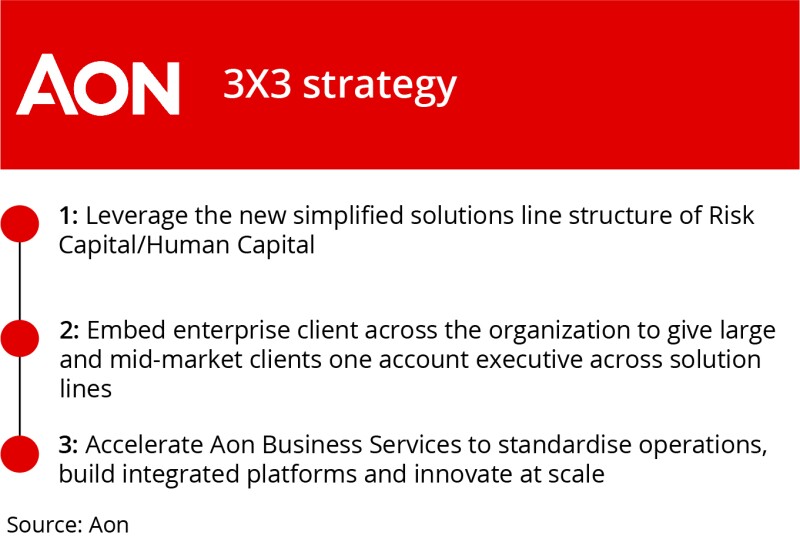Aon revealed a three-year plan alongside its results on Friday. (You can find the initial news story here, and an interview with CEO Greg Case here. Below is my take.)
The company would not state it this way, but in essence, the 3x3 plan will take Aon and make it even more Aon.
Aon has been charting a distinctive course over the last decade plus, which has made it an outlier on company structure, capital deployment, new product development, analytics investment and headcount growth (or relative lack thereof). It has also helped catapult the firm to remarkable financial performance, which in turn has driven major stock appreciation.
This plan is based around the intent to take the things that are distinctive about the firm today and intensify them.
First, it will look to build a more unified firm with stronger connectivity — furthering the work already undertaken to break down the dividing lines between commercial risk, reinsurance, health, benefits, wealth and talent. This can be traced back to moves that started in 2010, with its Aon United programme.
Second, more of the firm’s clients will be transitioned to a single point of contact with Aon, working with client executives that are expected to be across the whole range of capabilities. (This “enterprise client” approach was rolled out for Aon’s largest 400 clients over the last couple of years.)
And, third, the firm will look to roll out the next iteration of 2017-creation Aon Business Services, a unit with 15,000 staff that will act not just as an integrated back/middle office, but also as an analytics hub. Here again, Aon is seeking more integration around a business services and analytics platform that will create leverage, support new product development, and supercharge margins.
This is the 3x3. Three commitments, delivered in three years.

The ~$900mn charge over three years to deliver this is eye-catching, but it’s less than 10% of projected free cashflow. Indeed, with $350mn of projected annual cost savings by 2026, this looks either conservative at 2.6:1, or as if the spend skews heavily to technology investment. (The company declined to provide any breakdown on its earnings call.)
There are no figures on future margin expansion, but the past ~90 bps a year seems to be the baseline the company is working towards. There are questions around what a terminal margin might be, but it's clear that Aon doesn’t think the 34%-35% this would take it to by 2026 to is the top of the mountain. How close it can creep towards 40% over the next decade remains to be seen. The firm clearly intends to test the premise that technology, process and structure allow you to leverage headcount much more efficiently than in the past.
The three-year programme looks realistic and achievable, in part because all of these things are an evolution of the existing model and reflect a logical extension of the way CEO Case and his team see the world.
This is the kind of plan that will give investors incrementally greater confidence that Aon can continue moving the ball down the field, allowing it to extend its enviable financial track record of double-digit EPS growth, ~90 bps per year margin expansion and double-digit growth in free-cashflow. All of which points to further shareholder value creation.
All these changes are rooted in a conviction that the world is becoming riskier and more complex. In a world where businesses are being buffeted by geopolitical instability, inflationary pressures, the decoupling of global supply chains, the after-effects of the pandemic and climate change, they increasingly require integrated solutions.
Aon stresses that it is being hurried along in these planned changes by a combination of client need and secular forces.
Crucially, however, it is also trying to invest to build the infrastructure that would put it in a position to deploy technology at scale. In this regard, it is watching the development of generative AI and trying to give itself an option on using it as a transformational tool.
Aon has not been light on strategy or transformation during Case’s 18-year tenure as CEO. However, this is the first time it has chosen to put in place a multi-year strategy.
Codifying the different strands of strategy in a three-year plan makes sense given that Aon has moved past that initial period of refocusing following the Willis break-up, and given the intensification of the disruptive forces that are shaping the approach.
It also makes sense, however, from an investor relations perspective. Providing some fresh framing and a clear narrative to investors may help address the share price, which is lagging this year versus Marsh McLennan (+1% vs +11%), likely owing to the organic growth delta.
The growth gap has been evident for much of the last year, and this quarter Marsh McLennan was at 10%, ahead of Aon’s 6%, although the delta is magnified by the lack of fiduciary income in Aon’s number.
The weakness in the share price on Friday (down 4%) is not an early vote of confidence, but may reflect other factors like the free cashflow numbers.
Below the waterline
These are the parts of the strategy iceberg that are visible above the surface. But there are two important pieces below it that you can see dimly if you lean over the side of the boat and squint into the depths.
The succession question and major new compensation packages for key lieutenants
The M&A question, with Aon actively in the market looking for a major deal
1. The succession question
Aon very smartly squashed any real talk of whether Case would remain in place following the break-up of the Willis deal by extending the CEO’s contract by five years and announcing it immediately on the dissolution of the transaction.
But succession timing is complex. The appetite of the board and investors for a CEO to remain is critical — as is the executive’s hunger to continue. But it is also a question of talent retention.
Successful companies typically like to handle succession internally, and boards have to be attuned to the timing of key lieutenants, which owes something to the variable of their patience, and something to their opportunity set elsewhere.
Aon president Eric Andersen has been perceived for a number of years as heir presumptive to Case, although unlike, for example, John Doyle at Marsh McLennan, that role was not handed to him as part of a choreographed and clearly signposted handover.
At this stage, Andersen is likely to appear on the shortlist for every major CEO job in the sector — certainly in broking, and potentially on the carrier side too.
In this context, and with a view to aligning the most senior team for the three-year plan, Aon quietly made Andersen and CFO Christa Davies — the key leader for Aon Business Services — major stock awards alongside the firm’s Q2 results. Andersen also signed a contract extension until June 2026.
The three-year plans, contingent on financial performance hurdles, will make Andersen and Davies two of the best paid non-CEOs in the sector if they are successful. If Aon is able to continue on its current trendline, it will hit these triggers, which require roughly a ~14% share price CAGR.
2. The M&A question
Case told this publication that the increased operating leverage in the business — which is a function of its ever-higher margins — gives it the ability to evolve the way it deploys capital.
It was understandably close-lipped about what this might mean in practice, but it seems to represent a tacit acknowledgement that the firm is now potentially a buyer of broking assets at scale, rather than being primarily a buyer of its own stock. (The firm sounded more conservative on the earnings call during Davies’ section of the script.)
Historically, the firm’s capital deployment framework — which seeks to maximize return on invested capital — has encouraged it to heavily favour share buybacks. The management team has deployed ~$3bn in cash on M&A deals over the last eight years, compared to ~$17bn in share buybacks. Those M&A transactions have tended to be “capability” deals, such as cyber security firm Stroz Frieberg.
Even now, any M&A deals will have to find a way to clear the roughly 12%-14% hurdle rate that share buybacks represent. But with each dollar of incremental revenue increasingly profitable (as the firm ladders its way closer to a 35% adjusted operating margin) the math becomes easier to work out.
It is also aided by the increased cost of debt which has already made a dent in market liquidity for PE-backed platforms, and which has chipped away at platform multiples, with more erosion likely to come.
The best way to think about how the M&A piece ties to the broader three-year plan is that the three commitments, undergirded by the expectation of continuity in the top leadership team, provide an option to go big in M&A.
We are on the record in spring as saying Aon should buy a mid-market retail broker. They have at least laid the ground for this kind of move by meeting with half a dozen retailers including Epic-owner Galway, AssuredPartners and NFP, as well as with their approach for Hub International earlier this year.
There is an argument to be made for waiting a little longer for the pain of higher interest rates before biting further, and for a slow-down in organic growth to arrive. It should be kept in mind that the levered brokerage world is still in the process of working through the implications of the increased cost of debt.
That said, too long a wait combined with a successful IPO for one of the cohorts could give private equity owners greater confidence that they have options around their exits.
There is no perfect deal. Aon will have to accept trade-offs.
Galway offers Aon both a mid-market retail capability, a top-10 wholesaler, an MGA platform in Paragon and the biggest opportunity to drive margin accretion. However, it also comes with a significant amount of senior leadership looking to retire, has a heavier weighting to the upper mid-market and hasn’t built up the same M&A apparatus as other firms.
Aon would have to either pre-empt or come out on top in a sale process for AssuredPartners, which could create upward pressure on valuation and lower execution certainty. The firm has not grown strong organically and is thought to have further yet to go in terms of integration. In addition, founder Jim Henderson is expected to retire in relatively short order post-deal, with succession now in place in the form of CEO Randy Larsen and president Paul Vredenburg.
The firm has an attractive MGA operation but lacks wholesale broking.
NFP, on the other hand, is a more integrated business that has a well-oiled M&A machine and would also bring a recently united MGA platform. However, some believe that the firm’s culture could be more challenging to integrate into Aon. In addition, it has a higher weighting to benefits and wealth than its aforementioned peers — it's not yet clear that this is Aon’s focus.
Truist Insurance, meanwhile, offers wholesale and retail at scale, including significant MGA operations, with the business around the $1bn mark in Ebitda. However, revenue breakage in CRC would be huge, and McGriff has been a low growth business that has been quiet on M&A. (It seems more likely either that Stone Point will raise the money to buy down Truist’s stake, or that it will go public.)
There will be trade-offs for Aon as it weighs its options. But our conviction is that at least one deal will be struck.
As much as the 3x3 represents an important evolution and acceleration of Aon’s existing strategy, the cash-funded deal that the firm seemed open to would be perhaps the most consequential note from Friday’s communications.
The Aon 3x3 strategy graphic has been updated to clarify that the strategy comprises three commitments over three years, not one commitment per year.



